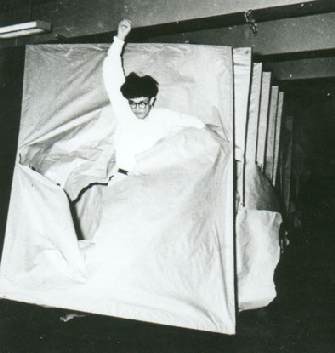
With our present-day awareness, the arts as we have known them up to now appear to us in general to be fakes fitted out with a tremendous affectation. Let us take leave of these piles of counterfeit objects on the altars, in the palaces, in the salons and the antique shops.
They are an illusion with which, by human hand and by way of fraud, materials such as paint, pieces of cloth, metals, clay or marble are loaded with false significance, so that, instead of just presenting their own material self, they take on the appearance of something else. Under the cloak of an intellectual aim, the materials have been completely murdered and can no longer speak to us.
Lock these corpses into their tombs. Gutai art does not change the material: it brings it to life. Gutai art does not falsify the material. In Gutai art the human spirit and the material reach out their hands to each other, even though they are otherwise opposed to each other. The material is not absorbed by the spirit. The spirit does not force the material into submission. If one leaves the material as it is, presenting it just as material, then it starts to tell us something and speaks with a mighty voice.
Jiro Yoshihara, The Gutai Manifesto (1956)

The Gutai were a wonderful movement. I have been interested in them for a while, but only rently did I come across the original Gutai Manifesto. It is a strange document. First of all, it sounds old. Nobody writes like that any more, nobody has this sort of ambitions and generalizing ideals. Think of the Dogma95 (and the other manifestos Von Trier wrote before it). They are political, activist-like, they are purposefully extreme, while trying to maintain a universal appeal. The Gutai seem from another world, way, way back. They are wilfully primitive, primary one could say. Of course, these are the 50's in Japan, the air is still filled with smoke, "civilization" still might sound funny. That's for the historical analysis. But the world has since changed not necessarily in the sense of a reconstruction, but rather, of an integration, a multiplication of forms that attempts to include movements such as the Gutai or the Dadaists (from the same family). But of course there is no particular thing that attempts anything. There is rather a proliferation of movements and ideas which all need a basis. And the (claimed) pureness of Gutai makes them perfect to grow upon. We can easily see artists ranging from Marina Abramovic to Matthew Barney use Gutai's dramatic staging of the limit of matter.
Another thing that surprised me in the Manifesto was the way it combines theory with a very down-to-earth (pardon the pun) description of the artists and their work that makes one think of publicity:
Other works which deserve mention are those of Yasuo Sumi produced with a concrete mixer or of Toshio Yoshida, who uses only one single lump of paint. All their actions are full of a new intellectual energy which demands respect and recognition.
At the same time, the Manifesto sounds honest. It is clearly one person's point of view ("In my case...", "there were many points I could agree with"), which is rare in any manifesto, to say the least. But it doesn't give us enigmatic, hermetic descriptions we are so used to in contemporary art. How often do I feel cheated (or stupid, or both) upon reading some artist's statement! It often seems the artists belong to some higher realm which only they can fully appreciate. Here...well, maybe I was too quick to say it isn't the case at all. Maybe it is the turning point? Since next to the theoretical descriptions are all these very concrete examples of what they mean. It might seem though as something too far-fetched to be credible. It obviously all comes down to personal taste, but if this train is too fast for you to take, you certainly won't enjoy much of what is being done today. Maybe that is what makes the Gutai a turning point: they take the action to another level of abstraction, through the gateway of fine art (in fine art, it had been done for some time before, though not with such a wonderful insistance on the romantic dance of man and matter).
It all sounds very honest, genuine. But from what I've been reading, and this is truly surprizing, the Gutai [link to French site] were hardly as spontaneous and work-focused (as opposed to publicity-focused) as they often appear. They repeated several actions in special performances for the journalists (Making a Work of Art with My Body, also called Challenging Mud, was one of them), and prepared them in quite a publicity-conscious way. Which would explain the commercial-like fragments of the Manifesto. But does it take away any of the credit? Who am I, who can admire music videos, TV commercials and well-designed chairs, to judge them?
"We have struggled to find our own method of creating a space rather than relying on our own self."

Technorati:

0 comments:
Post a Comment